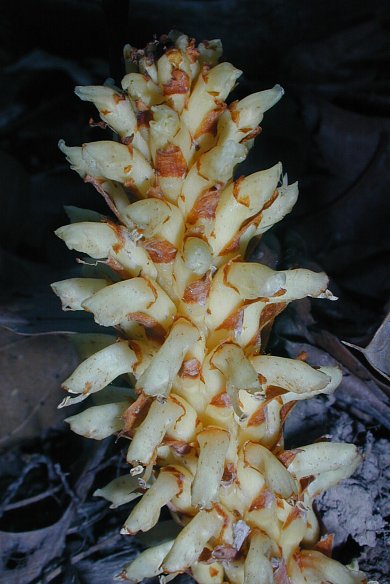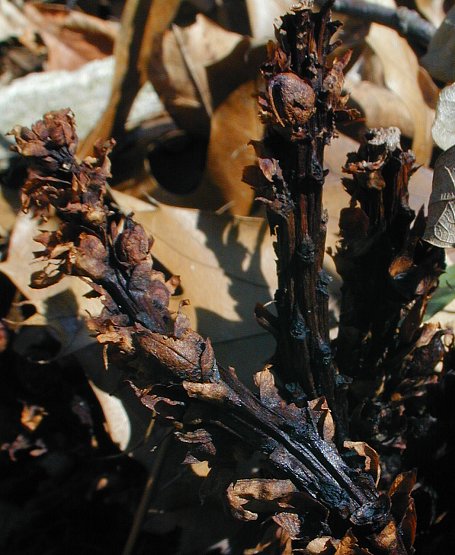Description: This herbaceous perennial plant is 3-8" tall and unbranched. It consists of a rather thick spike of flowers, while the leaves are reduced to scales. During the late spring this spike is cream-colored and hairless. Underneath each flower, there is an ovate scale up to ½" long that quickly turns brown. The flowers bloom during the late spring or early summer for about 3 weeks. They are densely crowded all around the spike, and begin to bloom from the bottom to the top. Each flower is about ½" long, consisting of a tubular corolla and a tubular calyx. Both the corolla and calyx are cream-colored, although the teeth of the calyx soon turn brown and wither away. The rest of the calyx wraps around the base of the corolla. The corollas of young flowers are initially semi-erect, but they spread outward from the spike with age. Each corolla has a convex upper lip that functions as a hood, while the poorly defined lower lip is smaller in size. Within the corolla, there are 4 stamens near the interior of the upper lip, and a single stout style that develops along the lower lip. Both the style and filaments of the stamens are white, while the anthers are grey. When the flowers are blooming, some of the stamens and styles may be exerted from their corolla tubes. There is no noticeable floral scent. Each flower is replaced by a seed capsule containing many small seeds; this seed capsule is longer than it is wide.

As the summer
progresses, the flowering spike begins to wither and becomes brown. It
can persist through the winter, by which time it has become shriveled
and black. The root system is parasitic on the roots of Quercus
spp. (Oak Trees); the suckers of the parasitic roots cause
the formation of large rounded knobs on the roots of the host tree.
Because Cancer Root doesn't produce chlorophyll, it is dependent on the
host tree for its nourishment. Small clusters of flowering spikes often
develop from the same root system. This plant spreads to new locations
by reseeding itself.
Cultivation:
This parasitic plant is indifferent to light levels. It requires the
presence of an Oak tree or its saplings at a well-drained site where
the soil is not too compacted.
Range & Habitat:
The native Cancer Root is an uncommon plant that has been observed in
central and
NE Illinois in several counties (see Distribution
Map).
Habitats
include upland woodlands, bluffs, wooded slopes and ravines, and
savannas. In all of these habitats, Quercus spp.
(Oaks) are invariably present. The flowering spikes of Cancer Root
often develop in areas where the leaf litter is scant. The greatest
threat to local populations is the invasion of Acer saccharum
(Sugar Maple) in Oak woodlands as a result of fire suppression.

Faunal
Associations:
The pollinators of the flowers have not been described for this species
to my knowledge. A related species, Orobanche uniflora
(One-Flowered Broomrape), is pollinated by bumblebees. Black Bears
forage on the flowering spikes of Cancer Root after they come out of
hibernation. There is also some evidence that deer browse on the
flowering spikes occasionally. Because it is possible that the seeds
can survive passage through the gastrointestinal tract, such animals
may help to disperse the seeds to new locations.
Photographic Location:
A bluff in Vermilion County, Illinois.
Comments:
This parasitic plant looks like a mutant pine cone or something from a
horror movie. Its closest relatives are Orobanche spp. (Broomrapes),
which are also parasitic and uncommon. The species Orobanche
ludoviciana (Prairie Broomrape) has a similar appearance with
thick white spikes of flowers, but the corollas of its flowers are
usually tinted lavender or pale purple and they are longer (about ¾" in
length). Another common name of Conopholis americana
is Squawroot.